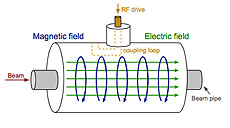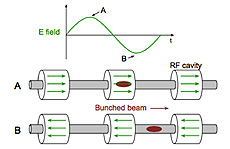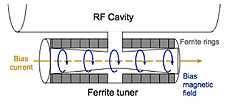Resonant cavities for the acceleration of charged particles
 |
| In an accelerating cavity, electric and magnetic fields are set up as shown here to accelerate a particle beam from one side to the other. |
In previous columns I have discussed some of the more interesting aspects of accelerating charged particles to high energies, but I have necessarily omitted important details. For example, my last column discussed phase stability and transition using an oscillating electric field, yet I gave no details for how such fields are produced.
Recall that substantial electric fields are required to accelerate charged particles to high energies. Early in our discussions we ruled out batteries and large electrostatic generators as viable ways to achieve energies at the MeV or higher scale. The most viable solution for achieving GeV energies is to arrange for the beam to pass through a substantial accelerating field many times. Even so, the problem remains difficult. For example, we cannot naively drill beam holes in two plates, install the plates in an accelerator, connect an AC voltage across the plates and hope to accelerate a proton beam with enough moxie to create serious a neutrino beam. Instead we must take a page from the radio engineering manual and make use of resonant cavities.
A resonant cavity allows us to set up a radio-frequency (RF) standing wave inside it with significant voltage and minimal power loss. The first figure (above) shows an example of a cavity with electric and magnetic field lines that result from exciting the cavity with an RF source. Both fields oscillate sinusoidally, reversing direction during each cycle as shown in the second figure (below). The bunched beam is present in the cavity only when the electric field is oriented to provide an acceleration. The oscillations make it possible for the standing wave to reach substantial potentials. By stringing cavities together, we can achieve on more than a million volts for each pass of the beam around the accelerator.
In order for the resonant cavities to be effective for accelerating particles, they must match the frequency of the beam bunches. This works well when the beam bunches arrive with a constant frequency. However, this is not always the case in an accelerator ring, especially when protons are being accelerated. For example, as the protons accelerate, their speed increases until they approach the velocity of light. This means the frequency of their arrival in the cavity increases during the early part of the acceleration cycle. For Fermilab's 8-GeV Booster and Main Injector accelerators, the increase in frequency is substantial enough that running the resonant cavities at a constant frequency would not work.
One way to change the frequency of a resonant cavity is to change its shape and size. However, this is not very practical since the change must occur during the acceleration cycle. One can imagine mechanical solutions involving moving parts, or a large, radiation-resistant, gorilla trained to deform the cavities at just the right time.
Fortunately, there is a better solution. It comes in the form of a ferrite-loaded transmission line that is attached to the accelerating cavity. The resonant frequency of the accelerating cavity changes when a current passes through the transmission line. The current changes the magnetic properties of the ferrite, changing the resonant frequency. Adjusting this bias current during acceleration allows the frequency of the RF cavity to follow the beam frequency. An example of a tuner coupled to a cavity is shown in the third figure (below).
As you can see, creating high-energy beams requires accelerator scientists to overcome many subtleties. We know it is worth the effort when we see the look on a young experimenter's face the first time she or he is finally convinced that there truly are neutrinos.
—Roger Dixon
Want a phrase defined? Have a question? Email today@fnal.gov
 |
| The acceleration of a particle beam is timed so that it arrives inside an accelerating cavity when the electric field inside it is at its peak (point A). That way, the electric field can push it forward and toward the next cavity. The particle beam's acceleration is also timed so that the beam is in between cavities when the cavities' electric field is at its lowest point (point B). Thus the beam idles in between pushes from one cavity to the next. |
 |
| A tuner helps adjust the accelerating frequency of a cavity by adjusting the current transmitted to it. This allows the accelerating cavity to follow the frequency of the beam's arrival in the cavity. |
|